Alara inn
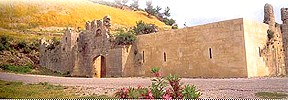 It is on the banks of the Alara Creek, on a flat land 800 metres away from the Citadel of Alara. It was built as a caravanserai on a land of two thousand metre square, using large stone blocks. The inn built in 1231 was restored a few years ago and today is used as a restaurant and a shopping centre. The watchman room is in good condition today. The second door of the caravanserai opens to the rooms of visitors. There are rooms along a corridor, on both sides. There is a fountain, a small mosque and a Turkish bath in the caravanserai. It is also noteworthy that some signatures of master builders were found during the restoration of the building. Alaaddin Keykubat was referred in the inscriptions in Alanya as “the Sultan of the land and the two seas, the owner of lands of Arabia and Persia, whereas in the inscription in Alara Inn he was also given the title of “the Conqueror of Damascus, Armenia and Europe”. You have to pay to enter the Inn. In addition to the restaurant there, you can eat at little countryside restaurants on the banks of the Alara creek and you can swim there until your meal is served.
It is on the banks of the Alara Creek, on a flat land 800 metres away from the Citadel of Alara. It was built as a caravanserai on a land of two thousand metre square, using large stone blocks. The inn built in 1231 was restored a few years ago and today is used as a restaurant and a shopping centre. The watchman room is in good condition today. The second door of the caravanserai opens to the rooms of visitors. There are rooms along a corridor, on both sides. There is a fountain, a small mosque and a Turkish bath in the caravanserai. It is also noteworthy that some signatures of master builders were found during the restoration of the building. Alaaddin Keykubat was referred in the inscriptions in Alanya as “the Sultan of the land and the two seas, the owner of lands of Arabia and Persia, whereas in the inscription in Alara Inn he was also given the title of “the Conqueror of Damascus, Armenia and Europe”. You have to pay to enter the Inn. In addition to the restaurant there, you can eat at little countryside restaurants on the banks of the Alara creek and you can swim there until your meal is served.
Bedesten
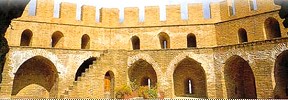 It’s in the citadel, near Sülaymaniye Mosque. It’s thought to have been be built in the 14th or the 15th century during the Karamanoğulları period as a bazaar or an inn. It’s a rectangular building made of stone blocks. It has 26 rooms and a courtyard that is 35 metres long and 13 metres wide. Today this historical building is used as a hotel, a restaurant and a cafe. The shops of the medieval times, overlooking the courtyard are now redesigned as hotel rooms. There’s a big cistern at the end of the stairs in the garden. The garden overlooks the above walls on one side, and the Taurus Mountains, the Mediterranean and the beach on the other side. Bedesten can be visited with the permission of the person who runs it.
It’s in the citadel, near Sülaymaniye Mosque. It’s thought to have been be built in the 14th or the 15th century during the Karamanoğulları period as a bazaar or an inn. It’s a rectangular building made of stone blocks. It has 26 rooms and a courtyard that is 35 metres long and 13 metres wide. Today this historical building is used as a hotel, a restaurant and a cafe. The shops of the medieval times, overlooking the courtyard are now redesigned as hotel rooms. There’s a big cistern at the end of the stairs in the garden. The garden overlooks the above walls on one side, and the Taurus Mountains, the Mediterranean and the beach on the other side. Bedesten can be visited with the permission of the person who runs it.
The Citadel of Alanya
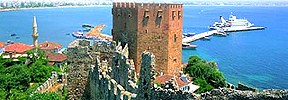 The Citadel of Alanya, the walls of which are nearly 6.5 kilometres long, is on a peninsula whose height is up to 250 metres from the sea level. Although the settlement on Alanya peninsula, also known as Kandeleri, dates back to the Hellenistic Era, its cultural characteristics that can be seen today are thanks to Selcuks of the 13th century. The citadel was constructed on the demand of the Sultan of Selcuks, Alaaddin Keykubat, who conquered and had the city rebuilt in 1221. The citadel has 83 towers and 140 bastions. Nearly 400 cisterns were built to supply the city surrounded by walks in the medieval times with water. Some of the cisterns are still used today. The walls were built in a well-planned manner; downwards to Ehmedek, İçkale, Adama Atacağı, the upper part of Cilvarda Bay, Arap Evliyası Burcu and Esat Burcu, then through the gun house and the dockyard and they end up in Kızılkule-İçkale, an open-air museum, is located at the peak of the peninsula. Alaaddin Keykubat, the Sultan, had his palace built there. Today the citadel is still inhabited by people. In front of wooden and brick houses of historical value, silk and cotton are woven, white gourds are painted in different figures and authentic meals are served in small gardens. There are also restaurants and cafés on the way to the citadel and on its sides overlooking the harbour. The citadel is open to traffic. It takes you nearly an hour to walk to the citadel.
The Citadel of Alanya, the walls of which are nearly 6.5 kilometres long, is on a peninsula whose height is up to 250 metres from the sea level. Although the settlement on Alanya peninsula, also known as Kandeleri, dates back to the Hellenistic Era, its cultural characteristics that can be seen today are thanks to Selcuks of the 13th century. The citadel was constructed on the demand of the Sultan of Selcuks, Alaaddin Keykubat, who conquered and had the city rebuilt in 1221. The citadel has 83 towers and 140 bastions. Nearly 400 cisterns were built to supply the city surrounded by walks in the medieval times with water. Some of the cisterns are still used today. The walls were built in a well-planned manner; downwards to Ehmedek, İçkale, Adama Atacağı, the upper part of Cilvarda Bay, Arap Evliyası Burcu and Esat Burcu, then through the gun house and the dockyard and they end up in Kızılkule-İçkale, an open-air museum, is located at the peak of the peninsula. Alaaddin Keykubat, the Sultan, had his palace built there. Today the citadel is still inhabited by people. In front of wooden and brick houses of historical value, silk and cotton are woven, white gourds are painted in different figures and authentic meals are served in small gardens. There are also restaurants and cafés on the way to the citadel and on its sides overlooking the harbour. The citadel is open to traffic. It takes you nearly an hour to walk to the citadel.
The Dockyard
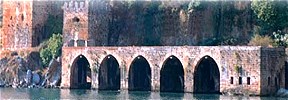 Its construction started in 1227, six years later than the Sultan’s conquest of the city, near Kızılkule and finished in one year. The Side of the dockyard overlooking the sea and having five cells with arches is 56.5 metres long and it is 44 metres in depth. The area selected for the dockyard was planned to have the most sunlight. The statement on the front door of the dockyard has the Sultan Keykubat’s armorial bearings and is decorated with badges. The dockyard of Alanya was the first one of Selcuks in the Mediterranean, Alaaddin Keykubat, who had the dockyard of Sinop built before, was given the little of “the Sultan of the two seas” with the opening of the dockyard of Alanya. On one side of the dockyard there is a small mosque, and a guard room on the other. There is a well that has dried up in time in one of the cells. You can go to the dockyard by boats or on foot passing the walls near Kızılkule and can enter the dockyard without any payments.
Its construction started in 1227, six years later than the Sultan’s conquest of the city, near Kızılkule and finished in one year. The Side of the dockyard overlooking the sea and having five cells with arches is 56.5 metres long and it is 44 metres in depth. The area selected for the dockyard was planned to have the most sunlight. The statement on the front door of the dockyard has the Sultan Keykubat’s armorial bearings and is decorated with badges. The dockyard of Alanya was the first one of Selcuks in the Mediterranean, Alaaddin Keykubat, who had the dockyard of Sinop built before, was given the little of “the Sultan of the two seas” with the opening of the dockyard of Alanya. On one side of the dockyard there is a small mosque, and a guard room on the other. There is a well that has dried up in time in one of the cells. You can go to the dockyard by boats or on foot passing the walls near Kızılkule and can enter the dockyard without any payments.
Ehmedek
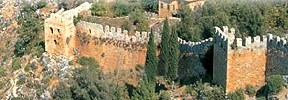 It was rebuilt and began to be known as the “middle castle” during the Selcuks’ Era, replacing the little one on the northern Side of the citadel left by the Byzantine Empire.
It was rebuilt and began to be known as the “middle castle” during the Selcuks’ Era, replacing the little one on the northern Side of the citadel left by the Byzantine Empire.
It’s clear from the inscription on its front door that it was built in 1227. It’s thought to have been named after the master builder “Ehmedek” of the Selcuks’ Era. The middle castle consisting of two parts with three towers is located on a strategically important place and at the same time it can protect the inner one where the Sultan’s palace is. The walls of the towers we can see today were built during the Byzantine Era, carving rocks. The three cisterns in the middle castle are still used today. There are pictures of ships on the walls dating back to Selcuks’ period.
Hıdırellez Church
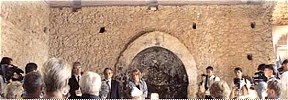 It is within the boundaries of Hacı Mehmetli Village in Hıdır İlyas, ten kms far from the center of Alanya.
It is within the boundaries of Hacı Mehmetli Village in Hıdır İlyas, ten kms far from the center of Alanya.
The church that is thought to have been founded on a slope overlooking the Mediterranean at the beginning of the 19th century is used for worshipping by Christian and Muslim visitors today. It is rectangular in shape, its roof is built of brick, its walls are made of stone and it has a little apse. There’s a mezzanine floor wooden decorated in the church. The frescos on the walls have been detoriated. It’s understood from the inscription that the church was repaired in 1873. The inscription being exhibited in Alanya Museum was written in Turkish (the language of Karamans), using the Greek alphabet. The church was closed when the people of Orthodox Church living in Alanya and speaking Turkish, went to Greece because of the exchange in 1924. Hıdırellez Church that has got a water source nearby is also known as the Church of Antalya Kaleiçi. Entrance to ruins is free.
Red Tower
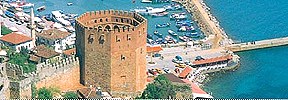 It’s in the harbour. The octagonal shaped building that’s the symbol of the city is a work by Selcuks of the 13th century. It was built in 1226 by Ebu Ali Rehç el Kettani, a master builder from Aleppo and had built the citadel of Sinop before on the demand of Alaaddin Keykubat, the Sultan of Selcuks. It was made of red bricks, the upper parts of which had been fired, since stone blocks were difficult to lift at a certain height, thus it was given the name of Kızılkule (Red Tower).
It’s in the harbour. The octagonal shaped building that’s the symbol of the city is a work by Selcuks of the 13th century. It was built in 1226 by Ebu Ali Rehç el Kettani, a master builder from Aleppo and had built the citadel of Sinop before on the demand of Alaaddin Keykubat, the Sultan of Selcuks. It was made of red bricks, the upper parts of which had been fired, since stone blocks were difficult to lift at a certain height, thus it was given the name of Kızılkule (Red Tower).
Marble blocks of the antiquity are seen in the walls of the citadel. The height of the tower that is octagonal in shape is 33 meters and it is 29 meters in diameter, its each wall is 12.5 metres long. There are five floors, including the ground floor. You can go to the top of the tower with the help of stone stairs that are high-spaced and have 85 steps. Sunlight coming from the top of the tower even reaches the first floor. There is a cistern in the middle of the tower. The tower was built in order to protect the harbour and the dockyard from naval attacks and was used for military purposes for centuries. Being restored in 1950s, the tower was opened to visitors in 1979, and its first floor began to be used as the museum of Ethnography.
Tophane
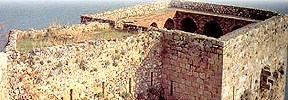 There’s a gun house next to the dockyard. It was built with the aim of defence on a rock ten meters above the sea level.
There’s a gun house next to the dockyard. It was built with the aim of defence on a rock ten meters above the sea level.
It’s also known that cannons for battleships were made in the three-storey and rectangular building made of stone blocks and constructed in 1277.
There have been some efforts made by the Ministry of culture and the Municipality of Alanya to make the Dockyard and the Gun House naval museums.


